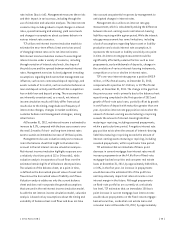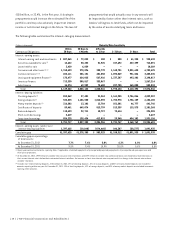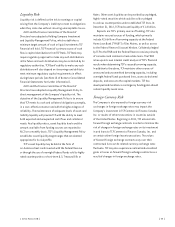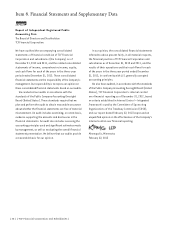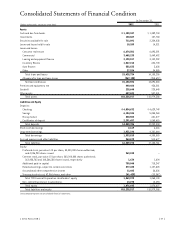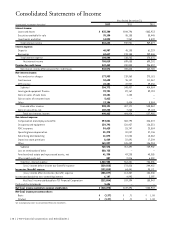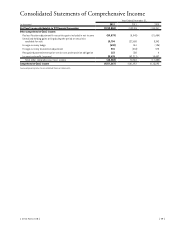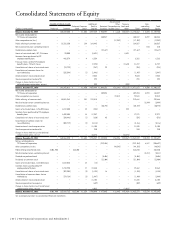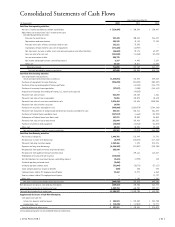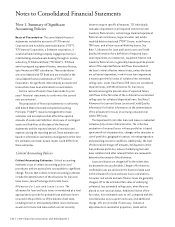TCF Bank 2012 Annual Report Download - page 79
Download and view the complete annual report
Please find page 79 of the 2012 TCF Bank annual report below. You can navigate through the pages in the report by either clicking on the pages listed below, or by using the keyword search tool below to find specific information within the annual report.90 days or four months after obtaining title or possession
of the property, are recorded as charge-offs against the
allowance for loan and lease losses. Subsequent valuation
adjustments are recorded as foreclosed real estate expense.
Deposit account overdrafts, which are included within other
loans, are charged-off at or before they are 60 days past
due. Commercial loans, leasing and equipment finance
loans, and inventory finance loans, which are considered
collateral dependent, are charged-off to estimated fair
value, less estimated selling costs, when it becomes
probable, based on current information and events, that
all principal and interest amounts will not be collectible
in accordance with contractual terms. Loans which are
not collateral dependent are charged-off when deemed
uncollectible based on specific facts and circumstances.
The amount of the allowance for loan and lease losses
significantly depends upon management’s estimates of
variables affecting valuation, appraisals of collateral,
evaluations of performance and status, and the amounts
and timing of future cash flows expected to be received.
Such estimates, appraisals, evaluations and cash flows
may be subject to frequent adjustments due to changing
economic prospects of borrowers, lessees or properties.
These estimates are reviewed periodically and adjustments,
if necessary, are recorded in the provision for credit losses
in the periods in which they become known.
Lease Financing TCF provides various types of
commercial lease financing that are classified for
accounting purposes as direct financing, sales-type or
operating leases. Leases that transfer substantially all
of the benefits and risks of ownership to the lessee are
classified as direct financing or sales-type leases and are
included in loans and leases. Direct financing and sales-
type leases are carried at the combined present value of
future minimum lease payments and lease residual values.
The determination of lease classification requires various
judgments and estimates by management including the fair
value of the equipment at lease inception, useful life of the
equipment under lease, estimate of the lease residual value
and collectability of minimum lease payments.
Sales-type leases generate dealer profit which is
recognized at lease inception by recording lease revenue
net of lease cost. Lease revenue consists of the present
value of the future minimum lease payments. Lease
cost consists of the leased equipment’s book value,
less the present value of its residual. Interest income
on direct financing and sales-type leases is recognized
using methods which approximate a level yield over the
fixed, non-cancelable term of the lease. TCF receives pro
rata rent payments for the interim period until the lease
contract commences and the fixed non-cancelable lease
term begins. TCF recognizes these interim payments in the
month they are earned and records the income in interest
income on direct finance leases. Management has policies
and procedures in place for the determination of lease
classification and review of the related judgments and
estimates for all lease financings.
Some lease financings include a residual value compo-
nent, which represents the estimated fair value of the
leased equipment at the expiration of the initial term of
the transaction. The estimation of residual values involves
judgment regarding product and technology changes,
customer behavior, shifts in supply and demand, and other
economic assumptions. TCF reviews residual assumptions on
the portfolio at least annually and downward adjustments,
if necessary, are charged to non-interest expense in the
periods in which they become known.
TCF occasionally sells minimum lease payments, as
a credit risk reduction tool, to third-party financial
institutions at fixed rates on a non-recourse basis with its
underlying equipment as collateral. For those transactions
which achieve sale treatment, the related lease cash flow
stream and the non-recourse financing are derecognized.
For those transactions which do not achieve sale treatment,
the underlying lease remains on TCF’s Consolidated
Statements of Financial Condition and non-recourse debt
is recorded in the amount of the proceeds received. TCF
retains servicing of these leases and bills, collects and
remits funds to the third-party financial institution. Upon
default by the lessee, the third-party financial institutions
may take control of the underlying collateral which TCF
would otherwise retain as residual value.
Leases which do not transfer substantially all benefits
and risks of ownership to the lessee are classified as
operating leases. Such leased equipment and related
initial direct costs are included in other assets on the
Consolidated Statements of Financial Condition and
depreciated, on a straight-line basis over the term of the
lease, to its estimated salvage value. Depreciation expense
is recorded as operating lease expense and included in
non-interest expense. Operating lease rental income is
recognized when it is due and is reflected as a component
of non-interest income. An allowance for lease losses is not
provided on operating leases.
{ 2012 Form 10K } { 63 }


